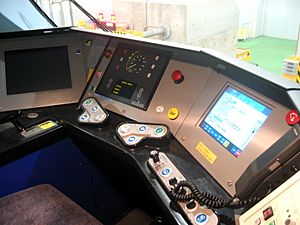Automatic train operation facts for kids
Automatic train operation (ATO) helps trains run by themselves. It uses computers and sensors to control the train, either partly or completely. This means the train driver has less to do, or sometimes no driver is needed at all!
Contents
How Does ATO Work?
ATO systems use smart technology to guide trains. They know where the train is and where it needs to go.
Brains of the Train
- Computers: These are like the train's brain. They decide when to speed up, slow down, or stop.
- Sensors: These are like the train's eyes and ears. They detect signals, track conditions, and other trains.
- Communication: Trains talk to control centers. This helps them stay safe and on schedule.
What ATO Can Do
ATO can handle many tasks that a human driver normally does.
- Starting and Stopping: It can make the train leave the station and stop precisely at the next one.
- Speed Control: It keeps the train at the right speed. This saves energy and makes the ride smooth.
- Door Control: In some systems, ATO can even open and close the train doors.
- Emergency Stops: If something unexpected happens, ATO can make the train stop quickly and safely.
Why Do We Use ATO?
Automatic train operation makes train travel better in many ways.
Safer Journeys
- Fewer Mistakes: Computers are very precise. They make fewer errors than humans, which makes train travel safer.
- Quick Reactions: ATO systems can react instantly to problems. This helps prevent accidents.
More Efficient Travel
- On Time: ATO helps trains stick to their schedules. This means fewer delays for passengers.
- Energy Saving: The system can control speed very smoothly. This uses less power and saves energy.
- More Trains: With ATO, more trains can run on the same tracks. This means more people can travel.
Levels of Automation
Not all ATO systems are the same. There are different levels, called Grades of Automation (GoA).
GoA 1: Manual Driving
- This is the lowest level. A driver controls everything.
- ATO might give advice, but the driver makes all decisions.
GoA 2: Semi-Automatic
- A driver is still in the cab.
- ATO helps with starting, stopping, and speed.
- The driver still opens and closes doors and handles emergencies.
- Many modern subway lines use GoA 2.
GoA 3: Driverless with Attendant
- The train runs fully automatically.
- There is still a person on board. This person helps passengers and deals with unusual situations.
- They do not drive the train.
GoA 4: Fully Driverless
- The train runs completely on its own.
- There is no staff member on board for driving duties.
- These trains are often found on dedicated lines, like airport shuttles.
- They can even handle emergencies by themselves.
Where is ATO Used?
ATO systems are used all over the world. They are common in big cities.
Subway Systems
- Many subway and metro lines use ATO.
- Cities like London, Paris, Singapore, and Tokyo have ATO trains.
- This helps them move millions of people every day.
Other Trains
- Some longer-distance trains also use ATO.
- It can help freight trains too, making them more efficient.
History of ATO
The idea of automatic trains is not new. Engineers have been working on it for a long time.
Early Developments
- Some of the first ATO systems appeared in the mid-20th century.
- They were often tested on short, dedicated lines.
Modern Systems
- Today's ATO systems are very advanced.
- They use powerful computers and smart sensors.
- Technology keeps improving, making trains even smarter.
Images for kids
See also
 In Spanish: Automatic Train Operation para niños
In Spanish: Automatic Train Operation para niños




